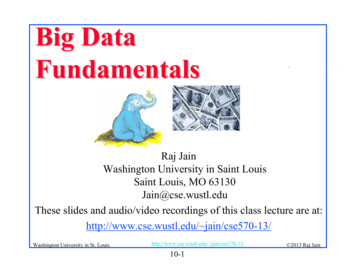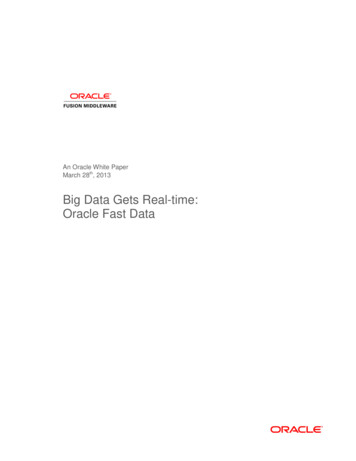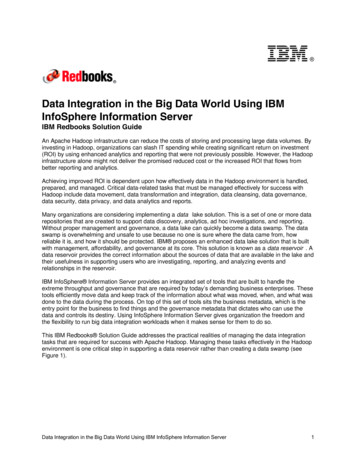
Transcription
Big DataFundamentals.Raj JainWashington University in Saint LouisSaint Louis, MO 63130Jain@cse.wustl.eduThese slides and audio/video recordings of this class lecture are at:http://www.cse.wustl.edu/ jain/cse570-13/Washington University in St. Louishttp://www.cse.wustl.edu/ jain/cse570-13/10-1 2013 Raj Jain
Overview1.2.3.4.5.Why Big Data?TerminologyKey Technologies: Google File System, MapReduce,HadoopHadoop and other database toolsTypes of DatabasesRef: J. Hurwitz, et al., “Big Data for Dummies,” Wiley, 2013, ISBN:978-1-118-50422-2http://www.cse.wustl.edu/ jain/cse570-13/Washington University in St. Louis10-2 2013 Raj Jain
Big Data Data is measured by 3V's:Volume: TBVelocity: TB/sec. Speed of creation or changeVariety: Type (Text, audio, video, images, geospatial, .)Increasing processing power, storage capacity, and networkinghave caused data to grow in all 3 dimensions.Volume, Location, Velocity, Churn, Variety,Veracity (accuracy, correctness, applicability) Examples: social network data, sensor networks,Internet Search, Genomics, astronomy, Washington University in St. Louishttp://www.cse.wustl.edu/ jain/cse570-13/10-3 2013 Raj Jain
Why Big Data Now?1.2.3.4.5.Low cost storage to store data that was discarded earlierPowerful multi-core processorsLow latency possible by distributed computing: Computeclusters and grids connected via high-speed networksVirtualization Partition, Aggregate, isolate resources in anysize and dynamically change it Minimize latency for anyscaleAffordable storage and computing with minimal man powervia clouds Possible because of advances in NetworkingWashington University in St. Louishttp://www.cse.wustl.edu/ jain/cse570-13/10-4 2013 Raj Jain
Why Big Data Now? (Cont)6.7.8.9.10.Better understanding of task distribution (MapReduce),computing architecture (Hadoop),Advanced analytical techniques (Machine learning)Managed Big Data Platforms: Cloud service providers, suchas Amazon Web Services provide Elastic MapReduce, SimpleStorage Service (S3) and HBase – column oriented database.Google’ BigQuery and Prediction API.Open-source software: OpenStack, PostGresSQLMarch 12, 2012: Obama announced 200M for Big Dataresearch. Distributed via NSF, NIH, DOE, DoD, DARPA, andUSGS (Geological Survey)Washington University in St. Louishttp://www.cse.wustl.edu/ jain/cse570-13/10-5 2013 Raj Jain
Big Data Applications Monitor premature infants to alert when interventions is neededPredict machine failures in manufacturingPrevent traffic jams, save fuel, reduce pollutionWashington University in St. Louishttp://www.cse.wustl.edu/ jain/cse570-13/10-6 2013 Raj Jain
ACID Requirements Atomicity: All or nothing. If anything fails, entire transactionfails. Example, Payment and ticketing.Consistency: If there is error in input, the output will not bewritten to the database. Database goes from one valid state toanother valid states. Valid Does not violate any defined rules.Isolation: Multiple parallel transactions will not interfere witheach other.Durability: After the output is written to the database, it staysthere forever even after power loss, crashes, or errors.Relational databases provide ACID while non-relationaldatabases aim for BASE (Basically Available, Soft, andEventual Consistency)Ref: http://en.wikipedia.org/wiki/ACIDWashington University in St. Louishttp://www.cse.wustl.edu/ jain/cse570-13/10-7 2013 Raj Jain
Terminology Structured Data: Data that has a pre-set format, e.g., AddressBooks, product catalogs, banking transactions,Unstructured Data: Data that has no pre-set format. Movies,Audio, text files, web pages, computer programs, social media,Semi-Structured Data: Unstructured data that can be put intoa structure by available format descriptions80% of data is unstructured.Batch vs. Streaming DataReal-Time Data: Streaming data that needs to analyzed as itcomes in. E.g., Intrusion detection. Aka “Data in Motion”Data at Rest: Non-real time. E.g., Sales analysis.Metadata: Definitions, mappings, schemeRef: Michael Minelli, "Big Data, Big Analytics: Emerging Business Intelligence and Analytic Trends for Today's Businesses,"Wiley, 2013, ISBN:'111814760Xhttp://www.cse.wustl.edu/ jain/cse570-13/Washington University in St. Louis 2013 Raj Jain10-8
Relational Databases and SQL Relational Database: Stores data in tables. A “Schema”defines the tables, the fields in tables and relationships betweenthe two. Data is stored one column/attributeOrder TableCustomer TableOrder NumberCustomer IDProduct IDQuantityUnit PriceCustomer ID Customer Name Customer Address Gender Income RangeSQL (Structured Query Language): Most commonly usedlanguage for creating, retrieving, updating, and deleting(CRUD) data in a relational databaseExample: To find the gender of customers who bought XYZ:Select CustomerID, State, Gender, ProductID from “CustomerTable”, “Order Table” where ProductID XYZ Ref: http://en.wikipedia.org/wiki/Comparison of relational database management systemshttp://www.cse.wustl.edu/ jain/cse570-13/Washington University in St. Louis10-9 2013 Raj Jain
Non-relational Databases NoSQL: Not Only SQL. Any database that uses non-SQLinterfaces, e.g., Python, Ruby, C, etc. for retrieval.Typically store data in key-value pairs.Not limited to rows or columns. Data structure and query isspecific to the data typeHigh-performance in-memory databasesRESTful (Representational State Transfer) web-like APIsEventual consistency: BASE in place of ACIDWashington University in St. Louishttp://www.cse.wustl.edu/ jain/cse570-13/10-10 2013 Raj Jain
NewSQL Databases Overcome scaling limits of MySQLSame scalable performance as NoSQL but using SQLProviding ACIDAlso called Scale-out SQLGenerally use distributed processing.Ref: http://en.wikipedia.org/wiki/NewSQLWashington University in St. Louishttp://www.cse.wustl.edu/ jain/cse570-13/10-11 2013 Raj Jain
Columnar DatabasesID101105106 Name SalarySmith10000Jones20000Jones15000In Relational databases, data in each row of the table is storedtogether: 001:101,Smith,10000; 002:105,Jones,20000; 003:106,John;15000 Easy to find all information about a person. Difficult to answer queries about the aggregate: How many people have salary between 12k-15k?In Columnar databases, data in each column is stored together.101:001,105:002,106:003; Smith:001, Jones:002,003; 10000:001, 20000:002, 150000:003 Easy to get column statisticsVery easy to add columnsGood for data with high variety simply add columnsRef: http://en.wikipedia.org/wiki/Column-oriented DBMShttp://www.cse.wustl.edu/ jain/cse570-13/Washington University in St. Louis10-12 2013 Raj Jain
Types of DatabasesRelational Databases: PostgreSQL, SQLite, MySQL NewSQL Databases: Scale-out using distributed processingNon-relational Databases: Key-Value Pair (KVP) Databases: Data is stored asKey:Value, e.g., Riak Key-Value Database Document Databases: Store documents or web pages, e.g.,MongoDB, CouchDB Columnar Databases: Store data in columns, e.g., HBase Graph Databases: Stores nodes and relationship, e.g., Neo4J Spatial Databases: For map and nevigational data, e.g.,OpenGEO, PortGIS, ArcSDE In-Memory Database (IMDB): All data in memory. For realtime applicationsCloud Databases: Any data that is run in a cloud using IAAS,VM Image, DAAShttp://www.cse.wustl.edu/ jain/cse570-13/ Washington University in St. Louis 2013 Raj Jain10-13
Google File System Commodity computers serve as “Chunk Servers” and storemultiple copies of data blocksA master server keeps a map of all chunks of files and locationof those chunks.All writes are propagated by the writing chunk server to otherchunk servers that have copies.Master server controls all read-write accessesName Space Block MapMaster ServerChunk ServerB1B2B3Chunk ServerB3B2B4ReplicateChunk ServerChunk ServerB4B4B2B1B3B1WriteRef: S. Ghemawat, et al., "The Google File System", OSP 2003, www.cse.wustl.edu/ jain/cse570-13/Washington University in St. Louis10-14 2013 Raj Jain
BigTable Distributed storage system built on Google File SystemData stored in rows and columnsOptimized for sparse, persistent, multidimensional sorted map.Uses commodity serversNot distributed outside of Google but accessible via GoogleApp EngineRef: F. Chang, et al., "Bigtable: A Distributed Storage System for Structured Data," tmlhttp://www.cse.wustl.edu/ jain/cse570-13/Washington University in St. Louis10-15 2013 Raj Jain
MapReduce Software framework to process massive amounts ofunstructured data in parallelGoals: Distributed: over a large number of inexpensive processors Scalable: expand or contract as needed Fault tolerant: Continue in spite of some failuresMap: Takes a set of data and converts it into another set ofkey-value pairs.Reduce: Takes the output from Map as input and outputs asmaller set of key-value pRef: J. Dean and S. Ghemawat, “MapReduce: Simplified Data Processing on Large Clusters,” OSDI osdi04.pdfhttp://www.cse.wustl.edu/ jain/cse570-13/Washington University in St. Louis10-16 2013 Raj Jain
MapReduce Example 100 files with daily temperature in two cities.Each file has 10,000 entries.For example, one file may have (Toronto 20), (New York 30),.Our goal is to compute the maximum temperature in the twocities.Assign the task to 100 Map processors each works on one file.Each processor outputs a list of key-value pairs, e.g., (Toronto30), New York (65), Now we have 100 lists each with two elements. We give thislist to two reducers – one for Toronto and another for NewYork.The reducer produce the final answer: (Toronto 55), (NewYork 65)Ref: IBM. “What is MapReduce?,” oop/mapreduce/http://www.cse.wustl.edu/ jain/cse570-13/Washington University in St. Louis10-17 2013 Raj Jain
MapReduce Optimization Scheduling: Task is broken into pieces that can be computed in parallel Map tasks are scheduled before the reduce tasks. If there are more map tasks than processors, map taskscontinue until all of them are complete. A new strategy is used to assign Reduce jobs so that it can bedone in parallel The results are combined.Synchronization: The map jobs should be comparables so thatthey finish together. Similarly reduce jobs should be comparable.Code/Data Collocation: The data for map jobs should be at theprocessors that are going to map.Fault/Error Handling: If a processor fails, its task needs to beassigned to another processor.Washington University in St. Louishttp://www.cse.wustl.edu/ jain/cse570-13/10-18 2013 Raj Jain
Story of Hadoop Doug Cutting at Yahoo and Mike Caferella were working oncreating a project called “Nutch” for large web index.They saw Google papers on MapReduce and Google FileSystem and used itHadoop was the name of a yellow plus elephant toy thatDoug’s son had.In 2008 Amr left Yahoo to found Cloudera.In 2009 Doug joined Cloudera.Ref: Michael Minelli, "Big Data, Big Analytics: Emerging Business Intelligence and Analytic Trends for Today's Businesses,"Wiley, 2013, ISBN:'111814760Xhttp://www.cse.wustl.edu/ jain/cse570-13/Washington University in St. Louis 2013 Raj Jain10-19
Hadoop An open source implementation of MapReduce frameworkThree components: Hadoop Common Package (files needed to start Hadoop) Hadoop Distributed File System: HDFS MapReduce EngineHDFS requires data to be broken into blocks. Each block isstored on 2 or more data nodes on different racks.Name node: Manages the file system name space keeps track of where each block is.Name Space Block MapName on University in St. Louishttp://www.cse.wustl.edu/ jain/cse570-13/10-20 2013 Raj Jain
Hadoop (Cont) Data node: Constantly ask the job tracker if there is somethingfor them to do Used to track which data nodes are up or downJob tracker: Assigns the map job to task tracker nodes thathave the data or are close to the data (same rack)Task Tracker: Keep the work as close to the data as possible.SwitchSwitchJob TrackerName NodeDN TTDN TTDN TTDN TTRackWashington University in St. LouisRackSwitchSec. Job TrackerDN TTDN TTRackSwitchSec. NNDN TTDN TTRackhttp://www.cse.wustl.edu/ jain/cse570-13/10-21DN Data NodeTT Task Tracker 2013 Raj Jain
Hadoop (Cont) Data nodes get the data if necessary, do the map function, andwrite the results to disks.Job tracker than assigns the reduce jobs to data nodes that havethe map output or close to it.All data has a check attached to it to verify its integrity.Washington University in St. Louishttp://www.cse.wustl.edu/ jain/cse570-13/10-22 2013 Raj Jain
Apache Hadoop Tools Apache Hadoop: Open source Hadoop framework in Java.Consists of Hadoop Common Package (filesystem and OSabstractions), a MapReduce engine (MapReduce or YARN), andHadoop Distributed File System (HDFS)Apache Mahout: Machine learning algorithms for collaborativefiltering, clustering, and classification using HadoopApache Hive: Data warehouse infrastructure for Hadoop.Provides data summarization, query, and analysis using a SQLlike language called HiveQL.Stores data in an embedded Apache Derby database.Apache Pig: Platform for creating MapReduce programs using ahigh-level “Pig Latin” language. Makes MapReduceprogramming similar to SQL. Can be extended by user definedfunctions written in Java, Python, etc.Ref: http://hadoop.apache.org/, http://mahout.apache.org/, http://hive.apache.org/, http://pig.apache.org/http://www.cse.wustl.edu/ jain/cse570-13/Washington University in St. Louis10-23 2013 Raj Jain
Apache Hadoop Tools (Cont) Apache Avro: Data serialization system.Avro IDL is the interface description language syntax for Avro.Apache HBase: Non-relational DBMS part of the Hadoopproject. Designed for larg
In 2008 Amr left Yahoo to found Cloudera. In 2009 Doug joined Cloudera. Ref: Michael Minelli, "Big Data, Big Analytics: Emerging Business Intelligence and Analytic Trends for Today's Businesses," Wiley, 2013, ISBN:'111814760X











